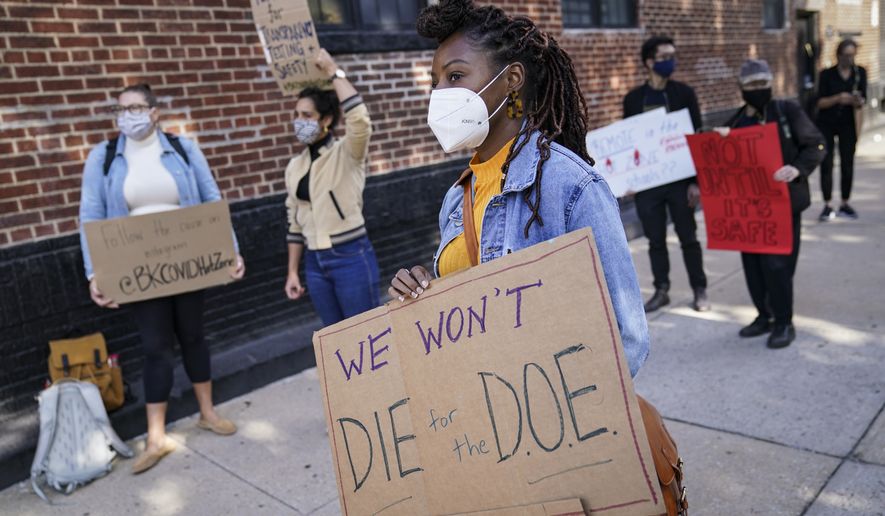More school districts are beginning to open up for in-person classes, but for many parents, the pace of reopening remains too slow, driven by teachers unions and politics rather than what is best for children.
The frustration sparked recent protests in California, Michigan, Oklahoma and Oregon.
Despite various amounts and grade levels of students returning to classrooms in places such as Florida and New York, 76% of parents across the country report that their children are still in school remotely or part time remotely as part of a hybrid schedule, according to a poll to be released Tuesday by the National Parents Union.
“It has become a political negotiation between teachers unions and superintendents and, frankly, parents want off the roller coaster,” said Keri Rodrigues, co-founder of the National Parents Union, an activist group advocating for parental input in public school decisions.
The roller-coaster ride continued in New York City, where Mayor Bill de Blasio last week victoriously declared, “We did it!” when sending thousands of middle and high school students back to the classrooms.
But on Monday, Gov. Andrew Cuomo stepped in to close schools again in neighborhoods across Brooklyn and Queens that experienced a spike in COVID-19 cases.
“I would not send my child to a school in a hot-spot cluster,” Mr. Cuomo said. “I am not going to recommend or allow any New York City family to send their child to a school that I wouldn’t send my child.”
The governor’s move bowed to the demands of the United Federation of Teachers, which threatened to sue if the city didn’t shut down public schools wherever the outbreak spread.
Michael Mulgrew, president of the city’s teachers union, praised the decision as one “that helps protect our schools, our neighborhoods and ultimately our city.”
In school districts across the country, however, parents aren’t convinced the focus of the school officials or teachers unions is on their children’s wellbeing.
Ms. Rodrigues, who shared some of her group’s polling data with The Washington Times, said half of the parents in the U.S. say they were left out of the reopening discussions.
“You have this teachers union that is using the closure of schools as the ultimate test of their political power in a kind of flex to show everyone that they can keep schools shut down just because they said so,” she said.
More than a month into the 2020-2021 school year, state-ordered full or partial school closures are in effect in seven states — California, Delaware, Hawaii, New Mexico, North Carolina, Oregon, West Virginia — and in Puerto Rico and Washington, D.C., according to data compiled by Education Week.
D.C. Public Schools announced Monday that in-person classes will resume Nov 9. for students in pre-kindergarten through fifth grade as part of a phased reopening plan.
Students in sixth through 12th grade will return to class in January.
“Learning at home is not working for every student. We particularly know that our youngest children are most challenged,” said D.C. Public School Chancellor Lewis D. Ferebee.
The Washington Teachers Union fought the reopening plan and pushed a long list of demands that included building upgrades, personal protective equipment and hiring more school staff.
Washington Teachers Union President Elizabeth Davis called on city officials to return to the negotiating table before teachers return to the classroom.
“The mayor and Chancellor Ferebee have failed to share the details of what COVID 19 safety measures have been instituted in each school. Their secrecy is a major part of our concern,” she said.
Schools have been ordered to fully reopen in four states: Arkansas, Florida, Iowa and Texas.
In the remaining 39 states, the decision for open, closed or hybrid schools is made by each school district.
Ms. Rodrigues posed a question asked by untold numbers of parents in school districts from Nags Head, North Carolina, to Laguna Beach, California.
“Why is indoor dining acceptable when you can’t have kids in school? Those kinds of decisions don’t make sense,” she said. “You are making a value judgment that it is more important to have indoor dining than it is to have in-person school. It is unfortunate.”
Randi Weingarten, president of the 1.7 million member-strong American Federation of Teachers, responded to an inquiry by The Washington Times about reopening schools by calling for the passage of House Democrats’ $2.2 trillion coronavirus relief bill.
She also slammed President Trump for threatening in July to withhold federal funds from public schools that didn’t fully open in the fall, though that punitive action never materialized.
“The American public has indicated that they can wait until after the election for a new Supreme Court justice, but they can’t wait for lifesaving COVID-19 relief. We urge the Senate to pass this $2.2 trillion relief package to support our schools, our states, our hospitals, our post offices and the people who need it,” she said in a statement.
“We all want to get back to in-person learning, but that should not happen until there are COVID-19 safety measures in place and the funding to pay for them. While teachers and parents have been toiling for months to try and reopen, Trump downplayed the virus.”
• S.A. Miller can be reached at smiller@washingtontimes.com.




Please read our comment policy before commenting.